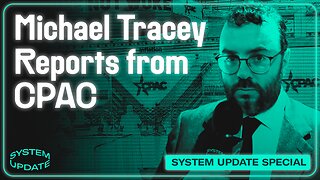Premium Only Content

Advocacy for vaping mushrooms Mycopharmaceuticals and Nutraceuticals
2. Fungi Contribution as Antioxidant and Anticancer Products’
Cited paper https://www.ncbi.nlm.nih.gov/pmc/articles/PMC8304235/
65. Uzma F., Mohan C.D., Hashem A., Konappa N.M., Rangappa S., Kamath P.V., Singh B.P., Mudili V., Gupta V.K., Siddaiah C.N., et al. Endophytic Fungi—Alternative Sources of Cytotoxic Compounds: A Review. Front. Pharmacol. 2018;9 doi: 10.3389/fphar.2018.00309. [PMC free article] [PubMed] [CrossRef] [Google Scholar]
66. Cardwell G., Bornman J.F., James A.P., Black L.J. A Review of Mushrooms as a Potential Source of Dietary Vitamin, D. Nutrients. 2018;10:1498. doi: 10.3390/nu10101498. [PMC free article] [PubMed] [CrossRef] [Google Scholar]
67. Kimatu B.M., Zhao L., Biao Y., Ma G., Yang W., Pei F., Hu Q. Antioxidant potential of edible mushroom (Agaricus bisporus) protein hydrolysates and their ultrafiltration fractions. Food Chem. 2017;230:58–67. doi: 10.1016/j.foodchem.2017.03.030. [PubMed] [CrossRef] [Google Scholar]
68. Vamanu E. Determination of antioxidant and antimicrobial properties of Agaricus bisporus from Romanian markets. Analele Univ. Ovid. Const. Seria Chimie. 2012;23:47–52. [Google Scholar]
69. Reis F.S., Martins A., Barros L., Ferreira I.C.F.R. Antioxidant properties and phenolic profile of the most widely appreciated cultivated mushrooms: A comparative study between in vivo and in vitro samples. Food. Chem.Toxicol. 2012;50:1201–1207. doi: 10.1016/j.fct.2012.02.013. [PubMed] [CrossRef] [Google Scholar]
70. Muna G.A., John M., Benson M., Ogoyi D. Antioxidant properties of cultivated edible mushroom (Agaricus bisporus) in Kenya. Afr. J. Biotechnol. 2015;14:1401–1408. [Google Scholar]
71. Patinho I., Saldaña E., Selani M.M., de Camargo A.C., Merlo T.C., Menegali B.S., de Souza Silva A.P., Contreras-Castillo C.J. Use of Agaricus bisporus mushroom in beef burgers: Antioxidant, flavor enhancer and fat replacing potential. Food. Prod. Process. Nutr. 2019;1:7. doi: 10.1186/s43014-019-0006-3. [CrossRef] [Google Scholar]
72. Gąsecka M., Magdziak Z., Siwulski M., Mleczek M. Profile of phenolic and organic acids, antioxidant properties and ergosterol content in cultivated and wild growing species of Agaricus. Eur. Food. Res. Technol. 2018;244:259–268. doi: 10.1007/s00217-017-2952-9. [CrossRef] [Google Scholar]
73. Hetland G., Johnson E., Lyberg T., Kvalheim G. The mushroom Agaricus blazei Murill elicits medicinal effects on tumor, infection, allergy, and inflammation through its modulation of innate immunity and amelioration of Th1/Th2 imbalance and inflammation. Adv. Pharmacol. Sci. 2011;2011:1–10. [PMC free article] [PubMed] [Google Scholar]
74. Shimizu T., Kawai J., Ouchi K., Kikuchi H., Osima Y., Hidemi R. Agarol, an ergosterol derivative from Agaricus blazei, induces caspase-independent apoptosis in human cancer cells. Int. J. Oncol. 2016;48:1670–1678. doi: 10.3892/ijo.2016.3391. [PubMed] [CrossRef] [Google Scholar]
75. Matsushita Y., Furutani Y., Matsuoka R., Furukawa T. Hot water extract of Agaricus blazei Murrill specifically inhibits growth and induces apoptosis in human pancreatic cancer cells. BMC Complement. Altern. Med. 2018;18:319. doi: 10.1186/s12906-018-2385-4. [PMC free article] [PubMed] [CrossRef] [Google Scholar]
76. Ohno S., Sumiyoshi Y., Hashine K., Shirato A., Kyo S., Inoue M. Phase I clinical study of the dietary supplement, Agaricus blazei Murill, in cancer patients in remission. Evid. Based. Complement. Alternat. Med. 2011;2011:192381. doi: 10.1155/2011/192381. [PMC free article] [PubMed] [CrossRef] [Google Scholar]
77. Taofiq O., Rodrigues F., Barros L., Peralta R.M., Barreiro M.F., Ferreira I.C.F.R., Oliveira M.B.P.P. Agaricus blazei Murrill from Brazil: An ingredient for nutraceutical and cosmeceutical applications. Food. Funct. 2019;10:565–572. doi: 10.1039/C8FO02461H. [PubMed] [CrossRef] [Google Scholar]
78. Lin W.-C., Deng J.-S., Huang S.-S., Wu S.-H., Chen C.-C., Lin W.-R., Lin H.-Y., Huang G.-J. Anti-inflammatory activity of Sanghuangporus sanghuang mycelium. Int. J. Mol. Sci. 2017;18:347. doi: 10.3390/ijms18020347. [PMC free article] [PubMed] [CrossRef] [Google Scholar]
79. Cai C., Ma J., Han C., Jin Y., Zhao G., He X. Extraction and antioxidant activity of total triterpenoids in the mycelium of a medicinal fungus, Sanghuangporus sanghuang. Sci. Rep. 2019;9:7418. doi: 10.1038/s41598-019-43886-0. [PMC free article] [PubMed] [CrossRef] [Google Scholar]
80. Bakir T., Karadeniz M., Unal S. Investigation of antioxidant activities of Pleurotus ostreatus stored at different temperatures. Food Sci. Nutr. 2018;6:1040–1044. doi: 10.1002/fsn3.644. [PMC free article] [PubMed] [CrossRef] [Google Scholar]
81. Gąsecka M., Mleczek M., Siwulski M., Niedzielski P. Phenolic composition and antioxidant properties of Pleurotus ostreatus and Pleurotus eryngii enriched with selenium and zinc. Eur. Food Res. Technol. 2016;242:723–732. doi: 10.1007/s00217-015-2580-1. [CrossRef] [Google Scholar]
82. Kumari M., Taritla S., Sharma A., Jayabaskaran C. Antiproliferative and Antioxidative Bioactive Compounds in Extracts of Marine-Derived Endophytic Fungus Talaromyces purpureogenus. Front. Microbiol. 2018;9 doi: 10.3389/fmicb.2018.01777. [PMC free article] [PubMed] [CrossRef] [Google Scholar]
83. Caicedo N.H., Davalos A.F., Puente P.A., Rodríguez A.Y., Caicedo P.A. Antioxidant activity of exo-metabolites produced by Fusarium oxysporum: An endophytic fungus isolated from leaves of Otoba gracilipes. Microbiol. Open. 2019;8:e903. doi: 10.1002/mbo3.903. [PMC free article] [PubMed] [CrossRef] [Google Scholar]
84. Pan F., Su T.-J., Cai S.-M., Wu W. Fungal endophyte-derived Fritillaria unibracteata var. wabuensis: Diversity, antioxidant capacities in vitro and relations to phenolic, flavonoid or saponin compounds. Sci. Rep. 2017;7:42008. doi: 10.1038/srep42008. [PMC free article] [PubMed] [CrossRef] [Google Scholar]
85. Toledo C., Barroetaveña C., Fernandes Â., Barros L., Ferreira I. Chemical and antioxidant properties of wild edible mushrooms from native Nothofagus spp. forest, Argentina. Molecules. 2016;21:1201. doi: 10.3390/molecules21091201. [PMC free article] [PubMed] [CrossRef] [Google Scholar]
86. Raman J., Jang K.-Y., Oh Y.-L., Oh M., Im J.-H., Lakshmanan H., Sabaratnam V. Cultivation and Nutritional Value of Prominent Pleurotus spp.: An Overview. Mycobiology. 2021;49:1–14. doi: 10.1080/12298093.2020.1835142. [PMC free article] [PubMed] [CrossRef] [Google Scholar]
87. González-Palma I., Escalona-Buendía H.B., Ponce-Alquicira E., Téllez-Téllez M., Gupta V.K., Díaz-Godínez G., Soriano-Santos J. Evaluation of the Antioxidant Activity of Aqueous and Methanol Extracts of Pleurotus ostreatus in Different Growth Stages. Front. Microbiol. 2016;7 doi: 10.3389/fmicb.2016.01099. [PMC free article] [PubMed] [CrossRef] [Google Scholar]
88. Zhang B.-B., Cheung P.C. Use of stimulatory agents to enhance the production of bioactive exopolysaccharide from Pleurotus tuber-regium by submerged fermentation. J. Agric. Food Chem. 2011;59:1210–1216. doi: 10.1021/jf104425w. [PubMed] [CrossRef] [Google Scholar]
89. Zhang B.-B., Chen L., Cheung P.C.K. Proteomic insights into the stimulatory effect of Tween 80 on mycelial growth and exopolysaccharide production of an edible mushroom Pleurotus tuber-regium. Biotechnol. Lett. 2012;34:1863–1867. doi: 10.1007/s10529-012-0975-7. [PubMed] [CrossRef] [Google Scholar]
90. Yap H.-Y.Y., Fung S.-Y., Ng S.-T., Tan C.-S., Tan N.-H. Shotgun proteomic analysis of tiger milk mushroom (Lignosus rhinocerotis) and the isolation of a cytotoxic fungal serine protease from its sclerotium. J. Ethnopharmacol. 2015;174:437–451. doi: 10.1016/j.jep.2015.08.042. [PubMed] [CrossRef] [Google Scholar]
91. Nallathamby N., Phan C.-W., Seow S.L.-S., Baskaran A., Lakshmanan H., Abd Malek S.N., Sabaratnam V. A Status Review of the Bioactive Activities of Tiger Milk Mushroom Lignosus rhinocerotis (Cooke) Ryvarden. Front. Pharmacol. 2018;8 doi: 10.3389/fphar.2017.00998. [PMC free article] [PubMed] [CrossRef] [Google Scholar]
92. Chai Y., Wang G., Fan L., Zhao M. A proteomic analysis of mushroom polysaccharide-treated HepG2 cells. Sci. Rep. 2016;6:23565. doi: 10.1038/srep23565. [PMC free article] [PubMed] [CrossRef] [Google Scholar]
93. Matuszewska A., Stefaniuk D., Jaszek M., Pięt M., Zając A., Matuszewski Ł., Cios I., Grąz M., Paduch R., Bancerz R. Antitumor potential of new low molecular weight antioxidative preparations from the white rot fungus Cerrena unicolor against human colon cancer cells. Sci. Rep. 2019;9:1975. doi: 10.1038/s41598-018-37947-z. [PMC free article] [PubMed] [CrossRef] [Google Scholar]
94. Sezer Y.Ç., Süfer Ö., Sezer G. Extraction of phenolic compounds from oven and microwave dried mushrooms (Agaricus bisporus and Pleurotus ostreatus) by using methanol, ethanol and aceton as solvents. Indian J. Pharm. Educ. Res. 2017;51:393–397. doi: 10.5530/ijper.51.3s.55. [CrossRef] [Google Scholar]
95. Boonsong S., Klaypradit W., Wilaipun P. Antioxidant activities of extracts from five edible mushrooms using different extractants. Agric. Nat. Resour. 2016;50:89–97. doi: 10.1016/j.anres.2015.07.002. [CrossRef] [Google Scholar]
96. Gebreyohannes G., Nyerere A., Bii C., Sbhatu D.B. Investigation of antioxidant and antimicrobial activities of different extracts of auricularia and Termitomyces species of mushrooms. Sci. World J. 2019;2019:1–10. doi: 10.1155/2019/7357048. [PMC free article] [PubMed] [CrossRef] [Google Scholar]
97. Abdullah N., Ismail S.M., Aminudin N., Shuib A.S., Lau B.F. Evaluation of selected culinary-medicinal mushrooms for antioxidant and ACE inhibitory activities. Evid. Based. Complement. Alternat. Med. 2012;2012:1–12. doi: 10.1155/2012/464238. [PMC free article] [PubMed] [CrossRef] [Google Scholar]
98. Zhou J., Diao X., Wang T., Chen G., Lin Q., Yang X., Xu J. Phylogenetic diversity and antioxidant activities of culturable fungal endophytes associated with the mangrove species Rhizophora stylosa and R. mucronata in the South China Sea. PLoS ONE. 2018;13:1–18. doi: 10
-
 1:09:33
1:09:33
Glenn Greenwald
12 hours agoMichael Tracey Reports from CPAC: Exclusive Interviews with Liz Truss, Steve Bannon & More | SYSTEM UPDATE #412
91.8K78 -
 56:02
56:02
Sarah Westall
8 hours agoBiohacking & Peptides: Weight loss, Anti-Aging & Performance – Myth vs Reality w/ Dr. Diane Kazer
41.4K14 -
 11:22
11:22
Bearing
18 hours ago"Anxious & Confused" Federal Workers FREAK OUT Over DOGE Efficiency Email 💥
56.3K61 -
 1:31:20
1:31:20
Flyover Conservatives
1 day agoUS STOCK MARKET: Sinking Ship - Dr. Kirk Elliott; How I Fought Back Against Woke Schools & Stopped Gender Bathrooms - Stacy Washington | FOC Show
62.8K1 -
 1:08:09
1:08:09
Donald Trump Jr.
13 hours agoFBI Dream Team, Plus Taking Your Questions Live! | Triggered Ep.219
202K267 -
 7:32:37
7:32:37
Akademiks
12 hours agoDrake and PartyNextDoor '$$$4U' Album Sells 250K first week. BIG AK IS BACK.
120K16 -
 3:12:08
3:12:08
MyronGainesX
11 hours ago $32.10 earnedDan Bongino Named As Deputy Director Of FBI And CPAC Recap
97.5K27 -
 3:12:31
3:12:31
vivafrei
11 hours agoBarnes Live from Seattle - Defending Benshoof in a Case that is CRAY CRAY!
155K47 -
 2:12:12
2:12:12
Robert Gouveia
11 hours agoLiberals EXPLODE over Elon's Email; Lawsuits FLY; Sanctions?? Congrats Dan!
116K38 -
 1:33:36
1:33:36
Redacted News
12 hours agoBREAKING! PUTIN LAUNCHES MASSIVE OFFENSIVE IN UKRAINE AS EUROPEAN LEADERS PUSH FOR MORE WAR
193K260